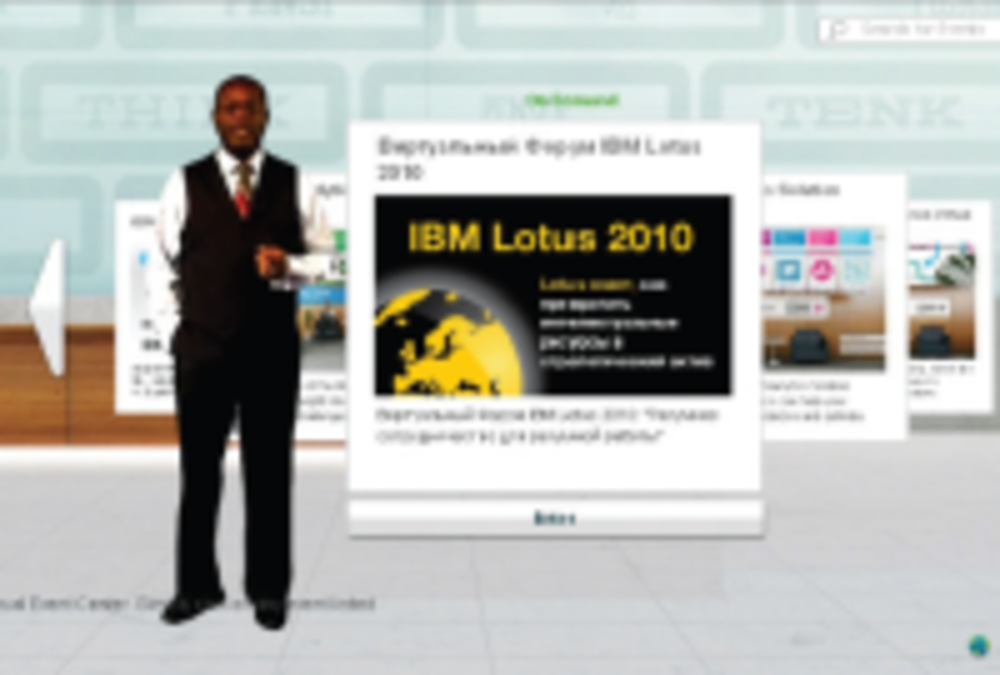Client: IBM
Agency: Unisfair
Outtake: Concerned that slashed
travel budgets would harm facetime
with potential and current
clients, b-to-b marketer IBM set
up a virtual event.
Imagine circulating in a virtual environment online with business executives from around the world. Your virtual briefcase is filled with presentations, documents and business cards and you’re mingling with exhibitor booth representatives in a virtual showroom. As companies manage global clients and prospects, they realize the advantage of working in 24/7 environments.
IBM is just one of many large organizations moving events to a virtual environment. Much of the transition started as a result of the lagging economy, said Joerg Rathenberg, VP of marketing at Unisfair, a virtual engagement platform provider. Luckily for Unisfair, they realized additional benefits along the way.
“Companies found it’s a whole different avenue, and they’re doing it as another way to network,” he added.
STRATEGY: As the cracks in the economy became apparent in 2008 and into 2009, IBM recognized that it would have an impact on people’s ability to meet face-to-face and network through industry events. The $96-billion global IT marketer wanted to continue meeting clients’ needs with an environment that allowed them to network and learn.
“The virtual platform seemed to be the best environment in which to do that,” said Cheryl Max, director of corporate functional capabilities at IBM. “With the number of countries we reach, virtual events allow us to be anywhere, anytime with clients.”
The IBM Virtual Event Center, which was launched in April 2010, offers a new way of networking and learning for its clients and prospects. Marketing created this environment to handle a plethora of topics such as product launches, multi-day meetings, virtual briefing centers and training for executives.
Max said IBM did not move into the virtual event space just because it’s the new thing everyone is talking about. The company examines the marketing dynamic, and designs marketing campaigns with tactics and executions to address business objectives and clients’ needs.
“You still have to figure out if it fits within your overall mix and objectives and not get blurred away from the bright, shiny object,” Max said.
IBM researched multiple agencies in the virtual space to understand the capabilities and offerings in the marketplace. It selected California-based Unisfair, which could support the organization’s needs on a global level. An aggressive schedule dictated a 90-day window to move to the new virtual platform. The group migrated some existing events onto the platform, rebranded and redesigned them, and loaded content to kick off its first event, the “Business Insight Forum 2010,” run by the Australian marketing team.
RESULTS: The Virtual Event Center proved successful for IBM’s marketing group in 2010. IBM has touched 18,000 clients and prospects through 80 virtual events run from 26 countries. Visitors have so far downloaded more than 15,000 documents, spending an average of two hours on the virtual platform. Costs average $10 to $20 per person. Attendance at events is on target with expectations and delivering positive response from attendees, IBM said.
In addition to reaching thousands of clients and prospects, the Virtual Event Center drives lead generation. The platform’s engagement index tracks the movement of people in the space to discover their interests. Companies also can define the ideal lead by filtering information provided by attendees. The challenge with virtual events, according to Max, is engagement. While it’s easy to run into someone in a hallway at a face-to-face event, virtual platforms are different.
“You have to create the right triggers and opportunities for people who are participating to engage with the speakers and one another,” Max said. “You have to think about the capabilities built into your platform for tweeting and interactions. We’ve certainly looked at enhancements to the platform.” As the economy is picking up, Max said virtual events become a great way to augment learning after an event or even extend their reach to more people in more countries. IBM plans to conduct around 100 virtual events in 2011.







